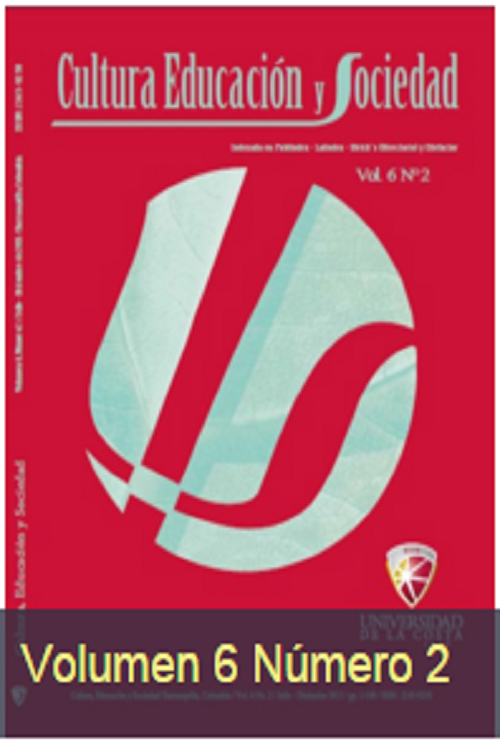Characterization of the phenomenon of Bullying from the perspective of the victim, perpetrator and witness
Keywords:
Bullying; victim; perpetrator; bystander; ColombiaAbstract
This article the problem of the phenomenon of bullying is presented from the perspective of the victim, the victimi-zer and the bystander within students from 6th to 11th degree of an educational institution in Sincelejo - Sucre, 2012. To describe the manifestations of bullying in this group of students an experimental model with a descrip-tive cross-sectional design analyzed from a quantitative approach with a probability sample that is supported in implementing adaptation CIMEI questionnaire (Avilés, 2003) was used; developed and used in a study conduc-ted by the Ombudsman (2000) in Colombia. As a result of this research it was found that students present ag-gressive, verbal, physical and psychological behavior causing distress, social isolation and even can affect the self-image of their classmates. Therefore, scientists in-puts showed in this study contribute to the process of continuous improvement of the institution, allowing the use of specific tools for handling and tackling bullying, impacting on the welfare of all students.
Downloads
References
Avilés, J. (2005). Estudio de incidencia de la intimidación y el maltrato entre iguales en la educación secundaria obligatoria mediante el cuestionario CIMEI (Avilés, 1999) –Cuestionario sobre Intimidación y Maltrato Entre Iguales–. Revista anales de Psicología. 21(1). 27-41
Avilés, J. (2003). Bullying: intimidación y maltrato entre el alumnado. Bilbao: STEE-EILAS.
Babbie, E. (1979). The practice of social research. Ed. Wadsworth. California
Becerra, F., Flores, V. & Vásquez, J. (2009). Acoso escolar (bullying) en lima Metropolitana. Texto no publicado UNFV.
Cepeda, E., Pacheco. P., García, L., & Piraquive, C, (2008). Acoso Escolar a Estudiantes de Educación Básica y Media. Revista de Salud Pública, 10(4). doi: S0124-00642008000400002
Cerezo, F., Calvo, A., Sánchez, C. (2010). Intervención psicoeducativa y tratamiento diferenciado del bullying. Madrid: Pirámide.
Defensor Del Pueblo (2000). Informe sobre violencia escolar: el maltrato entre iguales en la educación secundaria obligatoria. Disponible en: http://www.oei.es/oeivirt/Informeviolencia.pdf
Fernández, I., & Ortega (1998). La intervención del maltrato en el medio escolar, basada en la mejora de las relaciones interpersonales y de amistad entre iguales. Tabanque (18). 117-134. doi:10.1080/02103702.2014.881651
Espelage, D. L., & Swearer, S.M. (Eds.). (2004). Bullying in American schools: A social-ecological perspective on prevention and intervention. Mahwah, NJ: Erlbaum
Garaigordobil, M. & Oñederra, J. (2009) Inteligencia emocional en las víctimas de acoso escolar y en los agresores. European Journal of Education and Psychology. 3(2). 243-256
Juvonen, J. & Graham, S. (2001), Peer harassment in school. The plight of the vulnerable and victimized, pp. 355-377. New York: Guilford Press
Hoyos, O.; Aparicio, J. & Córdoba, P. (2005). Caracterización del maltrato entre iguales en una muestra de colegios de Barranquilla (Colombia). Psicología desde el Caribe.
Mazur, Mariel (2010). “Dinámica Bullying y Rendimiento académico en adolescentes”. Memoria de trabajo de grado. Universidad Católica de Uruguay. Montevideo, Uruguay
Marini, Z., Fairbairn, L., & Zuber, R. (2001). Peer harassment in individuals with developmental disabilities: Towards the development of a multi-dimensional bullying identification model. Developmental Disabilities Bulletin, 29, 170-195
Narváez, Víctor; Salazar, Omar. (2012). Bullying, matoneo, intimidación o acoso escolar. Carta de la Salud. (200).
Olweus, D. (1978). Aggresion in the school: Bullies and wipping boys. Washington D.C.: Hemisphere (Whiley). http://psycnet.apa.org/psycinfo/1979-32242-000
Olweus, D. (1998), Conductas de acoso y amenaza entre escolares, Madrid, Morata.
Oliveros M. & Barrientos A. (2007). Incidencia y factores de riesgo de la intimidación (bullying) en un colegio particular de Lima-Perú. Revista Perú Pediatría. 60(3). 150-155.
Ortega, R. & Mora-Merchán, J. (2000). Violencia escolar: mito o realidad. Sevilla, España: Mergablum.
Orte, C., (2001). Prevención de la violencia juvenil. Departamento de juventud. Diputación de Almería. Aportaciones de las investigaciones sobre violencia juvenil. Técnicas de intervención. Universidad de Illes Balears. Palma de Mallorca.
Paredes, M. T., Álvarez, M., Lega, L., Vernon, A. (2008). Estudio exploratorio sobre el fenómeno del “Bullying” en la ciudad de Cali, Colombia. Revista Latinoamericana de Ciencias Sociales, Niñez y Juventud. 6(1). 295-317.
Smith, PK., Morita, Y., Junger-Tas, J., Olweus, D., Catalano, R. & Slee, P. (eds) (1999). The nature of School Bullying: A Cross-national perspective. Londres: Routledge.
Smith, M. &Brownell, C. (2003). Childhood peer relationships: social acceptance, friendships, and peer networks. Journal of School Psychology. 41. 235-284 doi: 10.1016/S0022-4405(03)00048-7
Smith, P. K., Pepler. D., & Rigby, K. (2004). Bullying in schools: How successful can interventions Cambridge be?. Cambridge University Press. Australia
Sampieri, R. (2004) Metodología de la investigación, cuarta edición. Mc Graw Hill. México
Downloads
Published
How to Cite
Issue
Section
License
Copyright (c) 2015 CULTURA EDUCACIÓN Y SOCIEDAD

This work is licensed under a Creative Commons Attribution-NonCommercial-NoDerivatives 4.0 International License.
![]()
Creative Commons 2020 CULTURA EDUCACIÓN Y SOCIEDAD
This article is under international license Creative Commons Reconocimiento-NoComercial-SinObrasDerivadas 4.0.
The published articles are the sole responsibility of their authors and do not necessarily reflect the opinions of the editorial committee.
CULTURA EDUCACIÓN Y SOCIEDAD respects the moral rights of its authors, who assign to the editorial committee the patrimonial rights of the published material. In turn, the authors inform that this work is unpublished and has not been previously published.
All articles are under a:
Licencia Creative Commons Atribución-NoComercial-SinDerivadas 4.0 Internacional.
![]()


 English
English
 Español (España)
Español (España)




_12.53_.27_p_. m_._3.png)





_12.57_.35_p_. m_._3.png)
_12.50_.37_p_. m_._3.png)



